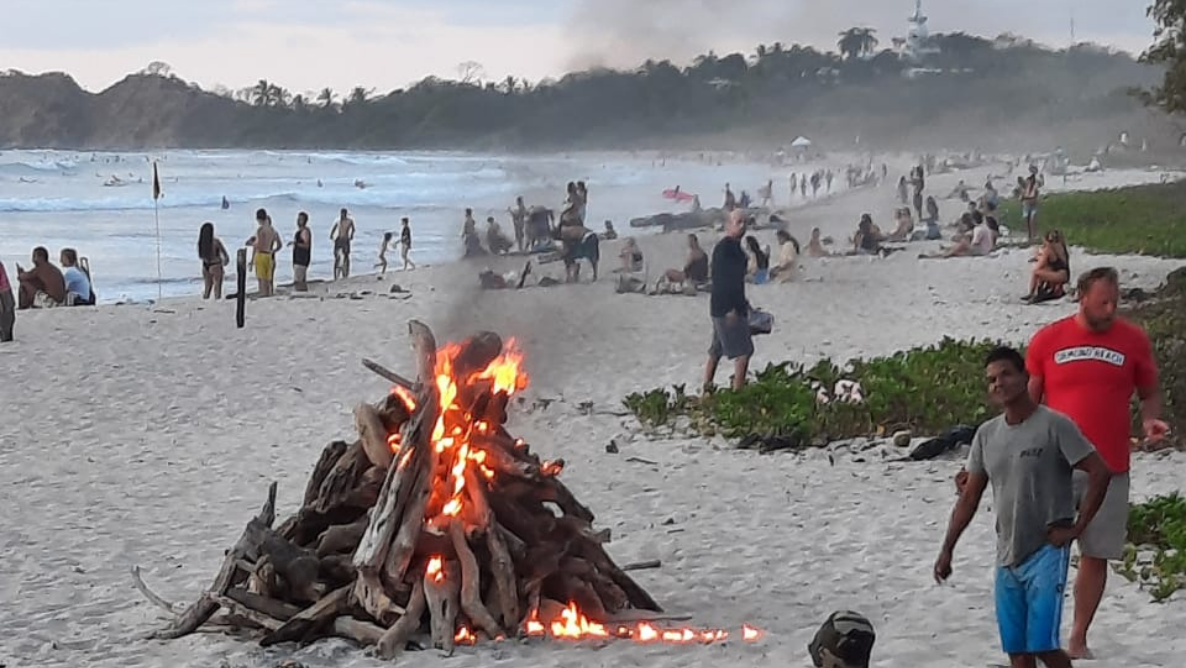Dusk falls, you are with your friends on the beach, they invite you to a refreshing drink. The colors of the cloudscape are spectacular and someone decides to make a bonfire. The moment is magical. No one wants to refuse to live it; however, as romantic and genuine as it may be, you have to know that this activity is putting the lives of many living beings at risk.
Although it is already well known that campfires are prohibited on the beaches within the Ostional National Wildlife Refuge (RNVO)- including Guiones and Pelada – the reasons for this prohibition are not as well known or understood.

The first thing you have to take into account is that in Guiones and Pelada there are Kemp Ridley turtle hatchings. The turtles come to the beach to lay their eggs every month and make their nests under the sand. The chances are very high that there are turtle nests under the campfire you are participating in, and those nests will be completely charred.
For Yeimy Cedeño, the administrator of the RNVO, the fires are not only a problem for the turtles. There are also many other organisms that live in the sandy area.
“We have seen in inspections how, in addition to finding completely burned turtle nests, there are other species such as crabs, caricacos and other organisms that live in the sand, which also die from the practice of fires,” explained Yeimy.
If this argument is still not enough, the park ranger also explained that many times animals such as coatis, raccoons and garrobos suffer from burns from the remains of the campfires.
Additionally, fire pit debris is also a risk to children playing in the sand, or anyone walking on the beach. Many people just put sand on top of the embers and the debris stays hot for several hours.
Other Lethal Risk
With the strong winds that are generated in the summer, coupled with the dryness of the vegetation and poor fire management, a campfire could lead to a forest fire.
During the last week of February, the Costa Rican National Emergency Commission declared a yellow alert in the cantons of Santa Cruz and Carrillo de Guanacaste due to forest fires that have consumed more than 10,000 hectares of forest; three times more than in 2021.
An orange alert was also declared in the districts of Tempate and Cabo Velas in Santa Cruz, as well as Sardinal in Carrillo.
Thanks to the work of the Costa Verdes organization, the vegetation has been restored on the beaches of the refuge. A fire in the area could erase the years of efforts to revegetate the shore.
According to Gerardo Bolaños, coordinator of Costa Verdes, in Guiones, during the last 10 years, forest cover has increased by 44% in the approximately 20 hectares of area that had been devoid of forest.
Although much remains to be done, we can say that the restoration process of the coastal forest has been advancing with great success in our community.
Unfortunately, the Refuge does not have enough park rangers and it is impossible for current officials to ensure that no one lights fires on the beach. The community also needs to share this responsibility.
How many protected areas are there in the country? Well, we in Nosara are fortunate to live near the Ostional National Wildlife Refuge, a space where the flora and fauna should not feel threatened by us humans.
There are plenty of other places you can build a fire without becoming a threat. The rule is not difficult to comply with; it is about commitment and love to take care of the wonderful treasure that we have and that belongs to all of Costa Rica.
At the Nosara Civic Association we have a dream of turning Nosara into a model community that values the well-being of all living beings. We want to invite you to help spread this information and support the refuge in eliminating campfires.
